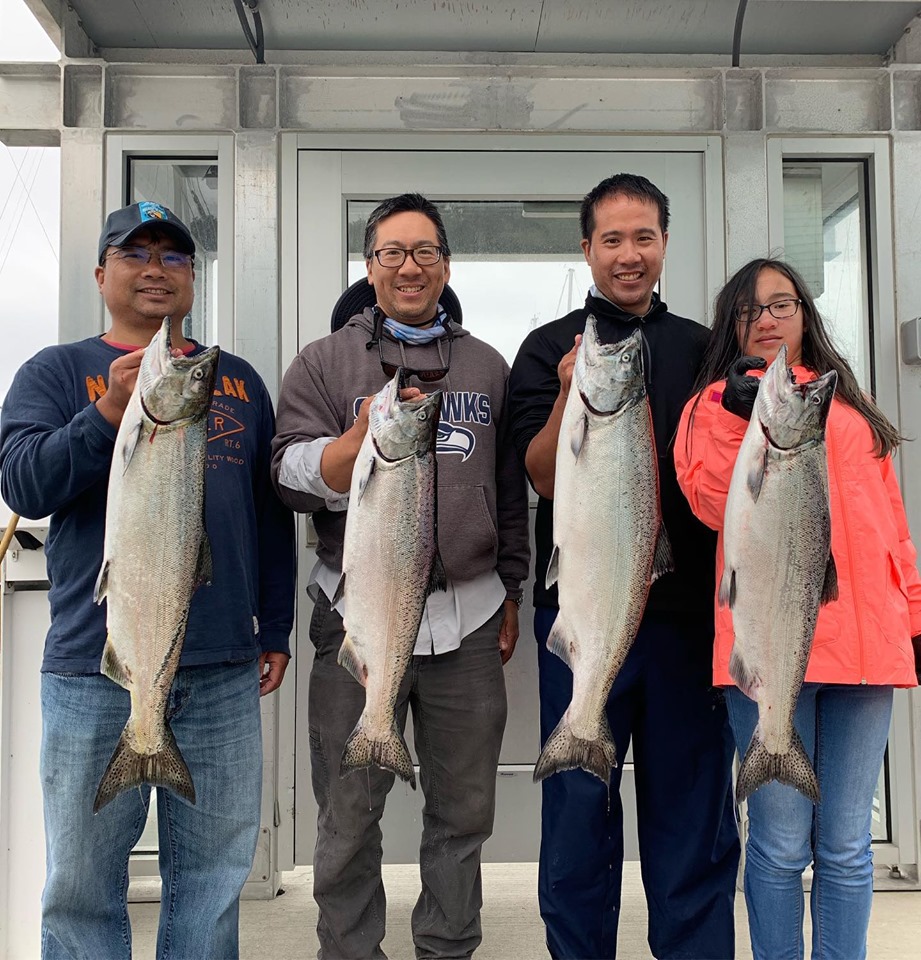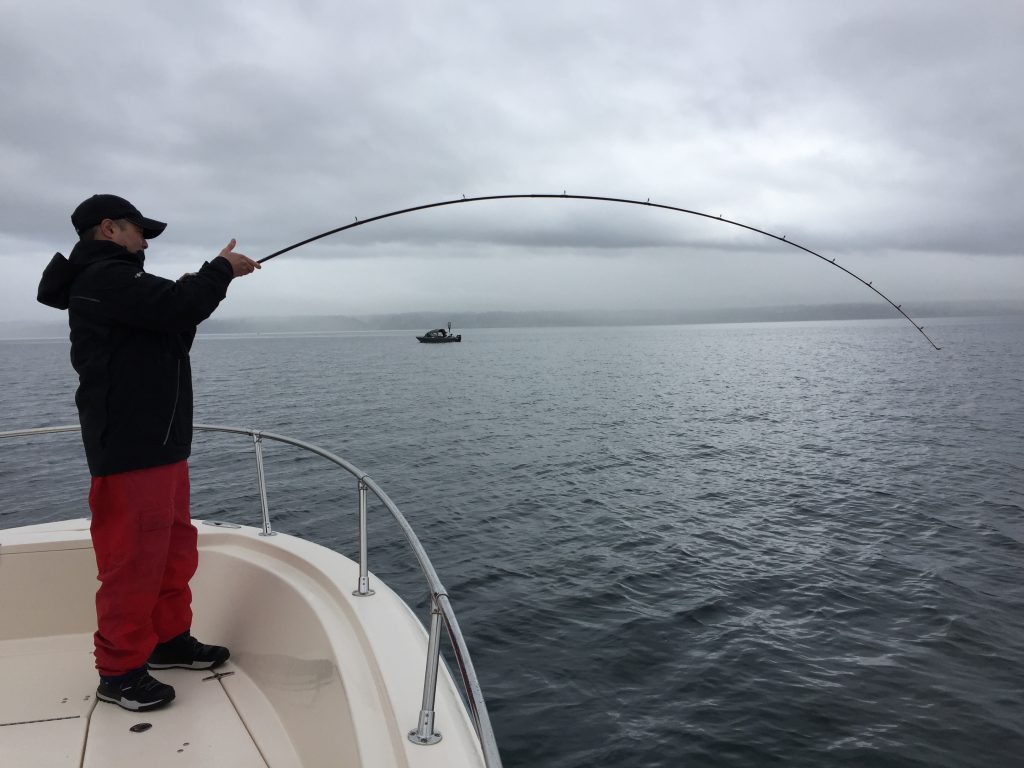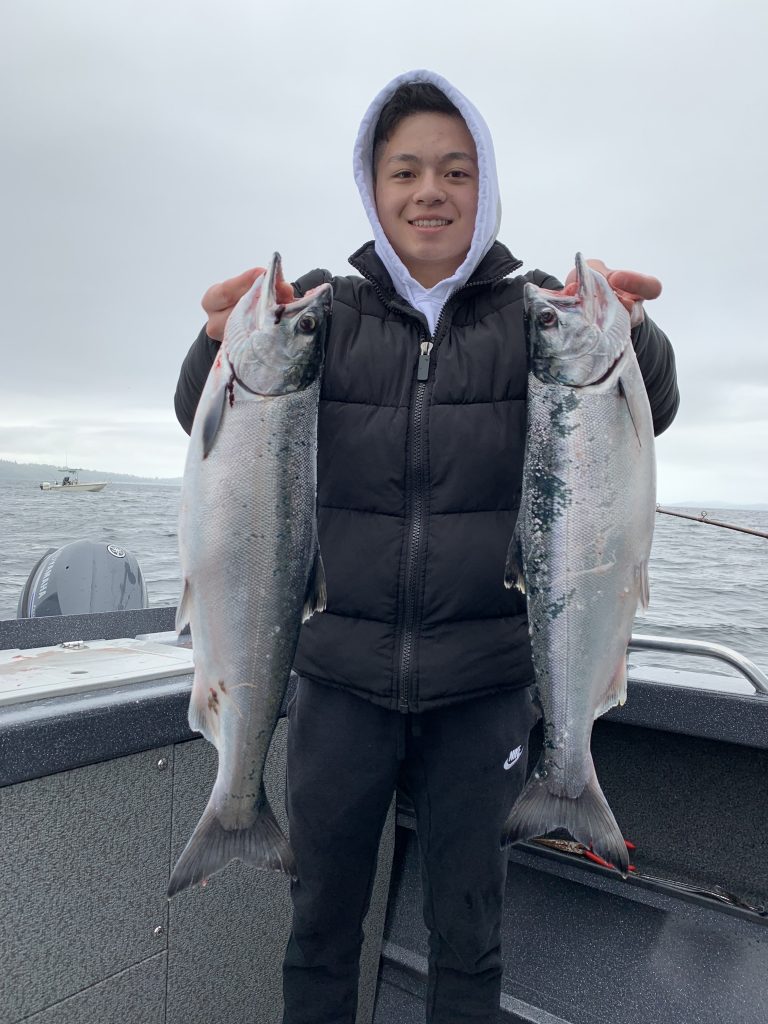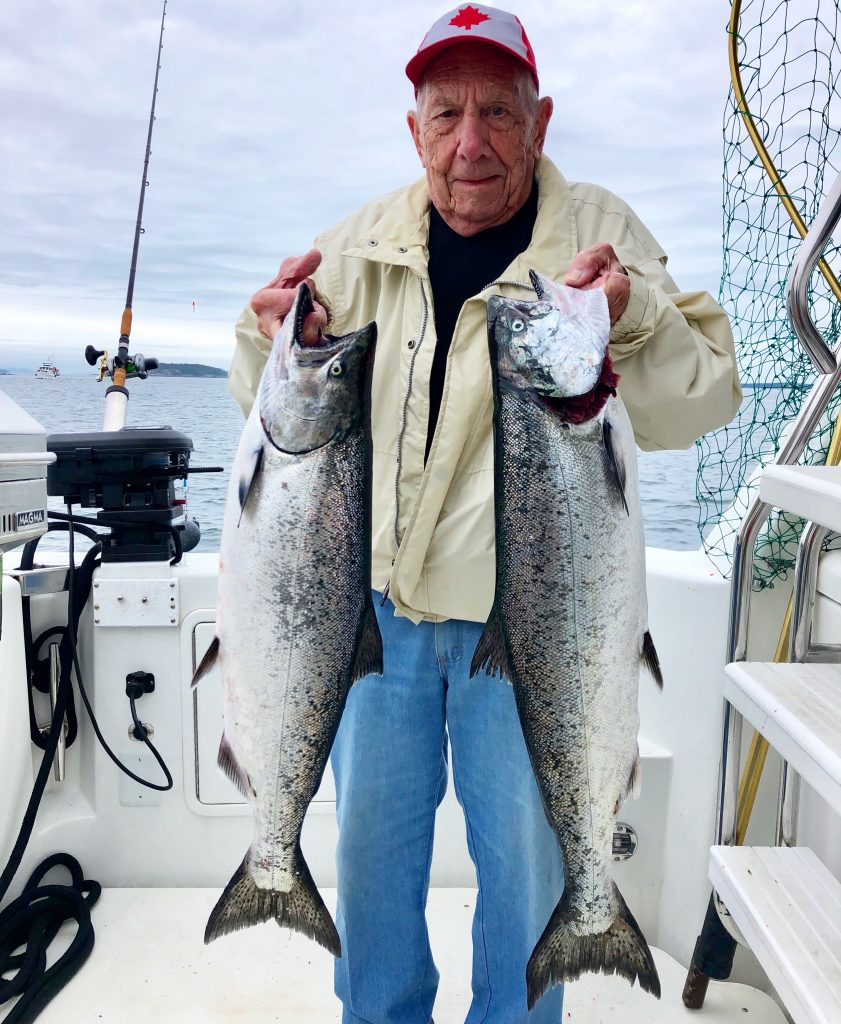August is a crowning moment for kings and other salmon in many marine areas Leave a reply

We’ve turned the corner on summer and are now headed into what I refer as one of the busiest times for Pacific Northwest anglers although many feel like the clock is working against them as they nail down as much time on the water before fall chores or back to school duties become the priorities.
In no order, anglers can now start pointing their rods toward open areas of Puget Sound; the Strait of Juan de Fuca; coastal ports and estuaries; Buoy 10 on the Columbia River mouth; and many other western Washington locations.
Word is the ocean salmon fisheries off Neah Bay, La Push, Westport and Ilwaco continue to produce some stellar hatchery coho fishing peppered with a few kings.
“Fishing was good again particularly down south off Ilwaco where they had a 1.4 salmon per person average, and most of those were coho,” said Wendy Beeghley, the WDFW coastal salmon manager. “It looks like the coho are indeed showing up in very good numbers and right in line with the preseason forecasts.”
Salmon catches are Westport were 0.92 salmon per rod average and most of the catch was coho. La Push had a 1.13 salmon per rod average and Neah Bay was 1.26, and it was mostly a coho or pink show.
“There were some guys who couldn’t get away from the pinks at La Push and Neah Bay,” Beeghley said. “The catch per rod could’ve been a lot higher as many folks were releasing a lot of pinks, and they’re nice in size (5 to 7 pounds). I did hear that people and a couple of Westport charter boats were starting to fund tuna about 35 miles out, which is relatively close.”

At Ilwaco a total of 4,548 anglers fished July 22-28 and kept 410 chinook (35% of quota) and 5,823 coho (33% of quota). At Westport, 3,348 anglers fished and landed 409 chinook (10%) and 2,588 coho (14%); La Push had 207 anglers with 23 chinook (21%) and 172 coho (8%); and Neah Bay had 638 anglers with 629 coho (25%). Retention of chinook at Neah Bay ended on July 14.
The pink show wasn’t just happening off the coast but has also started to spread into open areas of the Strait of Juan de Fuca from Sekiu to Port Angeles and few even trickling into northern Puget Sound from Port Townsend to southern end of Whidbey Island.
Earlier this summer I chatted with WDFW biologist Aaron Dufault who told me that they did a conservative forecast for pinks of 608,388, which was ranked among the lowest returns.
Maybe there’s a possibility that the ocean conditions for this summer’s returnees was brighter than expected. While we have conservative fishing measures in place this could mean that if we get a bunch back to the spawning grounds and with the cooler temperatures this summer and hopefully improved river conditions.
The Puget Sound pink run usually peaks in mid-August, and in southern Puget Sound the last week of August and early September are best.
If you haven’t taken a stroll down the red carpet along open areas of Puget Sound, then it might be time to hit the water as this is a crowning moment for hatchery kings.
The longer you wait works against you since many marine areas are managed under a hatchery chinook catch quota or guideline. Northern Puget Sound (Area 9) closed this past Saturday and WDFW will assess the catch to see if anything remains in the quota, which is unlikely.
One area that will remain open daily for hatchery chinook and is still producing good catches of resident coho and a few early pinks is central Puget Sound (10) which was at 26 percent of the 3,057 chinook catch quota.
Try Kingston, Jeff Head, Edmonds oil dock, Richmond Beach, West Point south of Shilshole Bay, Point Monroe, Yeomalt Point and Skiff Point off Bainbridge Island’s east side, Lincoln Park off West Seattle south to Brace Point, north side of Vashon Island near ferry landing and Dolphin Point as well as Southworth.

Other good options for kings are south central and southern Puget Sound (11 and 13) at Clay Banks off Point Defiance Park, Point Evans, Point Dalco off Vashon Island, entrance to Gig Harbor, Dolphin Point, Brace Point, Gibson Point and Point Fosdick, Fox Point in Hale Passage, northwest corner at the Sand Spit, Toy Point and the Concrete Dock Fox Island Fishing Pier.
In the Strait of Juan de Fuca, open marine areas off Sekiu, Freshwater Bay and Port Angeles have been fair for hatchery kings, plus some pinks and hatchery coho. King retention ends after Aug. 15 but remains open for hatchery coho and pinks.
Along the east side of Whidbey Island, Area 8-1 opened Aug. 1 but this is for coho and pinks only. The southern part of Area 8-2 opens Aug. 16 for hatchery coho only.
Shorebound anglers have opportunities to catch kings at Edmonds Pier, Des Moines Pier, Les Davis Pier and the Seacrest Pier in West Seattle. FYI: The Redondo Pier is closed for maintenance work and likely won’t reopen for some time. We don’t talk much about Hood Canal, but it has been producing some hatchery kings and the northern portion opened Aug. 1. Inner-Elliott Bay is open today (Monday, Aug. 5) for kings until 12 p.m. and WDFW will reassess the catch to see if additional days are possible.
There are some terminal chinook fisheries like the Tulalip bubble fishery and Sinclair Inlet that produce action in August.
On the coast Buoy 10 on Lower Columbia River opened Aug. 1 and has been surprisingly good since this past Thursday. The Willapa Bay and North Bay fishery in Grays Harbor also opened Aug. 1.
Before heading out the door, check the WDFW website at https://wdfw.wa.gov/ to see what is open or closed and what you can or can’t keep, plus any possible emergency closures this month.

Chinook by the numbers
Area 9 and 10 – 3,618 boats with 8,198 anglers July 25-28 kept 1,927 hatchery chinook and 3 unmarked chinook (55 percent of the 3,491-catch quota) and released 604 hatchery chinook for estimated total of 2,531 for 0.23 fish per rod average. The Area 10 catch kept was 810 for 26 percent of the 3,057-catch quota. The Area 9 legal-size chinook mark rate is 88.0 percent and the Area 10 legal-size chinook mark rate is 50.0 percent. Area 9 closed after this past Saturday and WDFW will reassess the catches to see if it can reopen.
Area 5 – 4,248 boats with 10,024 anglers July 1-28 kept 3,022 hatchery chinook and 5 wild chinook and released 2,132 hatchery chinook and 3,356 unmarked chinook for estimated total of 8,515. The Area 5 legal-size chinook mark rate is 67.4 percent and overall mark rate is 60.5 percent.
Area 7 (NOW CLOSED TO FISHING) – 5,146 boats with 11,382 anglers July 1-28 kept 2,921 hatchery chinook and 10 unmarked chinook and released 436 hatchery chinook and 905 unmarked chinook for estimated total of 4,272. The Area 7 legal-size chinook mark rate is 84.6 percent and overall mark rate is 78.6.
Area 11 – 6,459 boats with 12,112 anglers July 1-28 kept 1,470 hatchery chinook and 7 wild chinook and released1,346 hatchery chinook and 2,246 unmarked chinook for estimated total of 5,070. The Area 11 legal-size chinook mark rate is 100.0 percent and overall mark rate is 55.6 percent.
Puget Sound coho annual forecast comparisons
Here is historical data for Puget Sound coho that shows this seasons’ forecasted return of hatchery coho is on par with the 10-year average while the wild coho are falling short – 2003: 501,032 hatchery, 530,087 wild and 1,031,119 total; 2004: 508,425, 609,179 and 1,117,604; 2005: 461,341, 509,490 and 970,831; 2006: 548,466, 414,760 and 963,226; 2007: 338,268, 294,885 and 633,153; 2008: 330,800, 283,747 and 614,547; 2009: 338,968, 243,495 and 582,463; 2010: 314,004, 299,926 and 613,930; 2011: 375,607, 617,926 and 993,533; 2012: 367,241, 379,213 and 746,454; 2013: 417,226, 464,908 and 882,134; 2014: 432,299, 440,549 and 872,848; 2015: 421,626, 470,229 and 891,855; 2016: 168,585, 87,539 and 256,124; 2017: 300,713, 294,360 and 595,073; 2018: 307,975, 249,174 and 557,149; and 2019: 416,319, 293,980 and 710,299.
Total average: 2003 to 2019 is 385,229 hatchery, 381,379 wild and 766,608 combined. 5-year average: 323,044 hatchery, 279,056 wild and 602,100 combined. 10-year average: 352,160 hatchery, 359,780 wild and 711,940 combined.

